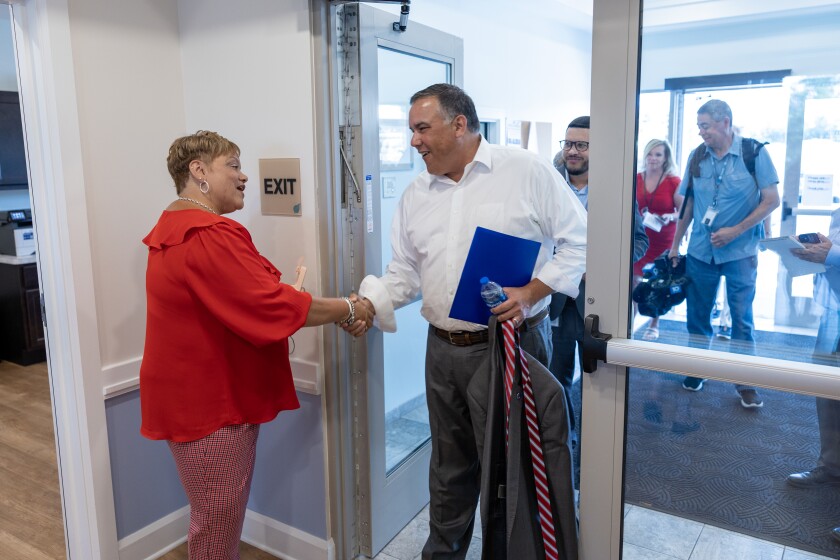The city helped fund the summer program. Ginther thanks the parents in attendance for their support and stops to talk with Nathan Harris, who’d participated in the camp during its inaugural year and went on to earn a Ph.D. in engineering at nearby Ohio State. “Over the last couple of years, I’ve put ARPA funds and other federal money into a record number of after-school programs,” Ginther says after leaving the camp, using the acronym for the American Rescue Plan Act. “We think that’s a major contribution in reaching historic lows in homicides and violent crime.”
Every mayor has two jobs: Running the city and representing it as the government’s most prominent public face. Ginther spent a recent Thursday pursuing both activities, showing up at a variety of events as a speaker, funder and cheerleader. “Mayors aren’t known for their patience — they want everything done yesterday,” Ginther tells a group of neighborhood commissioners and local business owners, “but you have to stay committed to that plan.”
Columbus has been experiencing rapid growth in both its population and its economy. Ginther recognizes that some parts of the city and many of its residents are being left behind, which is why he’s meeting with representatives from three underserved neighborhoods about progress they’ve made on plans for improvements sponsored by the city. Some projects are relatively modest, such as dog parks and produce markets, but not far away in the Linden area, a section of an abandoned strip mall is being converted into a health center.
“I’ve endured my share of criticism for focusing on a couple of key neighborhoods,” Ginther says, “but if the majority of people in this city are succeeding, everyone has to share in our success.”

Reading the Room
He was recruited as a tight end but switched to playing linebacker. “I realized I enjoyed hitting people a lot more than I enjoyed them hitting me,” he says.
Ginther still has a burly build but his manner is gentle. He clearly tries to meet people where they are, including children. Pulling up at the Hilltop Learning Center, he makes sure to bring in reading glasses. At 50, he can’t always make out the print and he knows he can’t fake it with kids who might have a favorite book already memorized. He’s delighted when he’s given a choice by one of the teachers who greets him, picking an oversized picture book called The Wheels on the Bus.

The city contributed $25 million to the construction of the learning center, which serves a community that previously had the lowest number of children in quality preschool programs of any section of the city. During Ginther’s time as mayor, the city has tripled the number of kids in early start programs, helping improve reading scores for third and fourth graders by double-digit percentages.
Having riled up the kids, Ginther sneaks away to a playroom filled with slides and padded mats to grab a sandwich and get a briefing on bus service from Monica Téllez-Fowler, the new president and CEO of the Central Ohio Transit Authority.

Working for You
Ginther’s security detail drives him around town in a black Ford Expedition, dropping cones to reserve the best spaces for easy access and departures. Ginther pulls blue folders out from the sun visor above his seat to look at his briefing papers, scanning talking points for stops where he needs reminders.
A mayor getting out of his car is always met at the door by staff from city agencies or the organizers hosting events. Anyplace that has a receptionist or a security guard, Ginther calls out a greeting on arrival and wishes that person a good day as he leaves.
At the ceremonial opening of an apartment building offering shelter and support services to older, formerly homeless individuals, Ginther is met by a reporter from WBNS, the local CBS affiliate. She warns him the air conditioning inside isn’t great, then asks him about workforce shortages within the fire department, along with questions about housing and homelessness.
Inside, Ginther leads off a string of about a dozen speakers from various nonprofits and the federal Department of Housing and Urban Development. “In Columbus, we believe everyone in our community deserves support,” Ginther tells the crowd of about 50 people.
The number of groups involved, he says after, is testimony to how complicated it is to put together financing for such projects.
At this stop, his security detail is more active than it’s been all day. One of the residents, a woman with mental health issues, has been yelling outside. Staff at the facility get her back to her room, which eases the security concerns and allows the mayor to leave as he came, through the front door.
After another quick hit with a local TV reporter, Ginther stops to talk with a woman named Kathryn. She’s in a wheelchair and complains there’s no way for her to get safely from the apartment building across busy Chatterton Road to a bus shelter. He assures her “we’ll get to work on it.”
“I honestly did vote for you,” Kathryn says.
“Whether you voted for me or not, I work for you now,” Ginther tells her.

Rolling Up His Sleeves
Ginther tries to dispense with his suit jacket during the warm summer months, preferring to wear his sleeves rolled up. He puts on a jacket and tie when appropriate, for instance when he ducks into a private meeting with an executive from a company considering relocating to Columbus.
Columbus is a physically large city, covering more than 220 square miles. After having stopped at a coffee shop first thing for a cappuccino, he rides around town for about 45 miles and takes almost seven hours to reach City Hall.
Checking in at his office, he pulls out business cards he’s collected through the course of his day, as well as several trading cards depicting cartoon dogs that he’d gotten from one of the kids he’s encountered. Ginther is now late for a meeting with Police Chief Elaine Bryant, in part because everywhere he’s been people have wanted to pose for pictures with him.
Bryant tells him about improvements in the homicide clearance rate, as well as dramatic improvements in solving non-fatal shootings. She talks about gun violence prevention programs and bringing down the time for tracing guns involved in crimes from more than 45 days to two or three.
Earlier in the day, Ginther had mentioned that there are two calls a mayor can never miss — those from his wife and from his police chief. Nevertheless, he apologizes to the chief and cuts short her briefing, explaining that one of his daughters is playing her first volleyball scrimmage as a high schooler.
“I'm going to go get my girl dad volleyball cheer outfit,” he says. “Appreciate you guys.”










